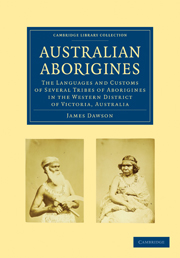 Australian Aborigines
Australian Aborigines Book contents
- Frontmatter
- PREFACE
- INTRODUCTORY NOTE
- Contents
- YARRUUN PARPUR TARNEEN
- CHAPTER I TRIBES
- CHAPTER II POPULATION
- CHAPTER III CHIEFS
- CHAPTER IV PROPERTY
- CHAPTER V CLOTHING
- CHAPTER VI HABITATIONS
- CHAPTER VII CLEANLINESS
- CHAPTER VIII DOMESTIC FURNITURE
- CHAPTER IX COOKING AND FOOD
- CHAPTER X TOOLS
- CHAPTER XI LAWS OF MARRIAGE
- CHAPTER XII CHILDREN
- CHAPTER XIII NAMES OF PERSONS
- CHAPTER XIV SUPERSTITIONS AND DISEASES
- CHAPTER XV DEATH AND BURIAL
- CHAPTER XVI AVENGING OF DEATH
- CHAPTER XVII GREAT MEETINGS
- CHAPTER XVIII AMUSEMENTS
- CHAPTER XIX WEAPONS
- CHAPTER XX ANIMALS
- CHAPTER XXI METEOROLOGY, ASTRONOMY, ETC
- CHAPTER XXII NATIVE MOUNDS
- CHAPTER XXIII ANECDOTES
- CONVEYANCE, BY PRINCIPAL CHIEFS TO JOHN BATMAN, OF 100,000 ACRES OF LAND, BETWEEN GEELONG AND QUEENSCLIFF
- VOCABULARIES.—WORDS; ANIMALS; RELATIONSHIPS; NAMES OF PLACES; GRAMMAR AND SENTENCES; NUMERALS
- NOTES
CHAPTER VII - CLEANLINESS
Published online by Cambridge University Press: 07 September 2010
- Frontmatter
- PREFACE
- INTRODUCTORY NOTE
- Contents
- YARRUUN PARPUR TARNEEN
- CHAPTER I TRIBES
- CHAPTER II POPULATION
- CHAPTER III CHIEFS
- CHAPTER IV PROPERTY
- CHAPTER V CLOTHING
- CHAPTER VI HABITATIONS
- CHAPTER VII CLEANLINESS
- CHAPTER VIII DOMESTIC FURNITURE
- CHAPTER IX COOKING AND FOOD
- CHAPTER X TOOLS
- CHAPTER XI LAWS OF MARRIAGE
- CHAPTER XII CHILDREN
- CHAPTER XIII NAMES OF PERSONS
- CHAPTER XIV SUPERSTITIONS AND DISEASES
- CHAPTER XV DEATH AND BURIAL
- CHAPTER XVI AVENGING OF DEATH
- CHAPTER XVII GREAT MEETINGS
- CHAPTER XVIII AMUSEMENTS
- CHAPTER XIX WEAPONS
- CHAPTER XX ANIMALS
- CHAPTER XXI METEOROLOGY, ASTRONOMY, ETC
- CHAPTER XXII NATIVE MOUNDS
- CHAPTER XXIII ANECDOTES
- CONVEYANCE, BY PRINCIPAL CHIEFS TO JOHN BATMAN, OF 100,000 ACRES OF LAND, BETWEEN GEELONG AND QUEENSCLIFF
- VOCABULARIES.—WORDS; ANIMALS; RELATIONSHIPS; NAMES OF PLACES; GRAMMAR AND SENTENCES; NUMERALS
- NOTES
Summary
It is worthy of remark that nothing offensive is ever to be seen near the habitations of the aborigines, or in the neighbourhood of their camps; and although their sanitary laws are apparently attributable to superstition and prejudice, the principles of these laws must have been suggested by experience of the dangers attendant on uncleanness in a warm climate, and more deeply impressed on their minds by faith in supernatural action and sorcery. It is believed that if enemies get possession of anything that has belonged to a person, they can by its means make him ill; hence every uncleanness belonging to adults and half-grown children is buried at a distance from their dwellings. For this purpose they use the muurong pole (yam stick), about six or seven feet long, with which every family is provided. With the sharpened end they remove a circular piece of turf, and dig a hole in the ground, which is immediately used and filled in with earth, and the sod so carefully replaced that no disturbance of the surface can be observed. Children under four or five years of age, not having strength to comply with this wholesome practice, are not required to do so; and their excreta are deposited in one spot, and covered with a sheet of bark, and when dry they are burned. It may be as well to say here, that, besides this sanitary use of the muurang pole, it is indispensable in excavating graves and in digging up roots, and is a powerful weapon of warfare in the hands of the women, who alone use it for fighting.
- Type
- Chapter
- Information
- Australian AboriginesThe Languages and Customs of Several Tribes of Aborigines in the Western District of Victoria, Australia, pp. 12 - 13Publisher: Cambridge University PressPrint publication year: 2009First published in: 1881
